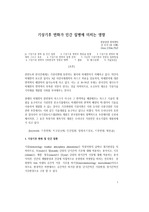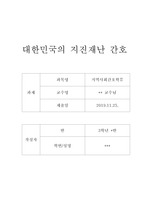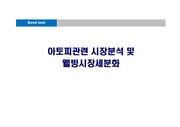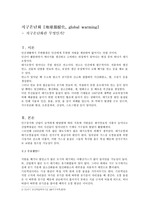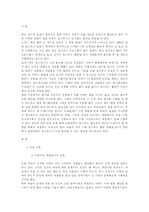

-
미리보기
목차
1. 기상기후 변화 및 인간 질환
2. 기상기후 변화와 병원균 발생
3. 기상기후 변화와 매 개체 그리고 숙주
4. 기상기후 변화와 질병 전파
5. 극심한 기상이변과 전염성 질환창궐
6. 기상기후 변화의 사회환경적 영향과 대책
7. 결론본문내용
요론
한반도와 한국인에게는 기상이변에 동반하는 황사와 미세먼지가 지배하고 있다. 약간의미세먼지 보도만 있어도 3살 어린이에게까지 마스크 착용을 강요하여, 미세먼지에 대한 면역력의 배양까지 불가능하게 하고 있다. 이는 곧 30~50년 후에는 한국인의 대다수가 미세먼지 면역력이 부족한 국민이 된다는 것을 의미하므로, 소규모의 새로운 기상기술 기자재를 개발할 기회를 부여해주는 것이다.
현재의 미세먼지 완전방지 마스크가 아니라 그 면역력을 배양해주는 마스크 기술의 개발을 요구하므로 기상전문 중소기업에서도 미세먼지와 면역력 배양의 빅-데이터 기술을 이용하여 개발할 수 있는 것이다. 기후변화와 기상이변은 이와 유사한 다종다양한 기상 관련 부문에서도 이와 같은 기술개발을 요구하고 있다고 하겠다. 특히 우리나라의 휴전선 말라리아 조기경보시스템(EWS) 계발은 한국정부에서 정책적으로 추진해야할 우선과제이지만, 그 요인 측정기와 계측기의 개발은 우리나라 기상전문 중소기업의 개발과제가 되고 있다.
1. 기상기후 변화 및 인간 질환
기상(meteorology: weather: atmospheric phenomena)은 특정지방의 날씨나 대기현상을 의미하므로, 주(week)나 월(month) 단위의 단기간적 기후에 대해 적용하는 용어이고, 기후(climate)는 계절・절후(season)나 년(year) 단위의 장기간적 기상에 대해 적용하는 용어이지만, 인간의 생활환경과 건강에 직접적으로 순영향과 악영향을 미치는 전후좌우・상방향의 1km 이내의 공간적 기상・기후를 미기상(micrometeorology: microclimate)이라고 하므로, 환경적인 측면에서는 공간적인 미기상 환경, 단기간적인 기상환경, 장기간적인 기후환경으로 구분 할 수 있다.
기후변화(climate change)는 날씨와 기상의 장기적・통계적 변화성이므로, 기상 조건의 평균적 변화도 포함하고, 기상 조건의 평균적 분포(극심적, 극한적 날씨)도 포함하고 있다. 지구상 기후변화의 원인은 아직도 완전하게 규명되어 있지 않지만, 현상태로 진행 되고 있는 기후변화는 적으나마 인류의 산업활동(industrial activity)에 기인하는 것으로 인식하는 관점이나 시각이 일반화되어 있다.참고자료
· Xiaoxu Wu, et al., “Impact of climate change on human infectious diseases:
· Empirical evidence and human adaptation”, Environ. Internat., 86, 2016, pp.14~23
· Costello, A., et al., “Managing the health effects of climate change”, Lancet, 373,
· 2009, pp.1773~1964.
· Willox, A.C., et al., “Examining relationships between climate change and mental
· health in the Circumpolar North”, Reg. Environ. Chang., 15, 2015, pp.169~182.
· Tian, H.Y., et al., “How environmental conditions impact mosquito ecology and
· Japanese encephalitis: an eco-epidemiological approach”, Environ. Int., 79, 2015, pp.17~24.
· Chretien, J.P., et al.,“Global climate anomalies and potential infectious disease risks”,
· PLoS Curr. 2014, p.7.
· Thomson, M.C., et al., “Malaria early warnings based on seasonal climate forecasts
· from multi-model ensembles”, Nature, 439, 2006, pp.576~579.
· Mellor, P.S., Leake, C.J., “Climatic and geographic influences on arboviral infections
· and vectors”, Rev. Sci. Tech., 19, 2000, pp.41~54.
· Harvell, C.D., et al., “Climate warming and disease risks for terrestrial and marine
· biota”, Science, 296, 2002, pp.2158~2162.
· 76
· Bunyavanich, S., et al., “The impact of climate change on child health”, Ambul.
· Pediatr., 3, 2003, pp.44~52.
· Woodward, A., Liu, Q., “Temperature and mortality on the roof of the world: a
· time-series analysis in three Tibetan counties”, Sci. Total Environ., 485, 2014, pp.41~ 48.
· Jones, K., “Campylobacters in water, sewage and the environment”, J. Appl.
· Microbiol., 90, 2001, pp.68~79.
· Obiri-Danso, K., Paul, N., Jones, K., “The effects of UVB and temperature on the
· survival of natural populations and pure cultures of Campylobacter jejuni, Camp. coli,
· Camp. lari and urease-positive thermophilic campylobacters in surface waters”, J. Appl.
· Microbiol., 90, 2001, pp.256~267.
· Hofstra, N., “Quantifying the impact of climate change on enteric waterborne
· pathogen concentrations in surface water”, Curr. Opin. Environ. Sustain., 3, 2011,
· pp.471~479.
· Semenza, J.C., Menne, B., “Climate change and infectious diseases in Europe”,
· Lancet, Infect. Dis., 9, 2009, pp.365~375.
· Shaman, J., Kohn, M., “Absolute humidity modulates influenza survival, transmission
· and seasonality”, PNAS, 106, 2009, pp.3243~3248.
· Islam, M.S., et al., “Effects of local climate variability on transmission dynamics of
· cholera in Matlab, Bangladesh”, Trans. R. Soc. Trop. Med. Hyg., 103, 2009,
· pp.1165~1170.
· Schlesinger, P., Mamane, Y., Grishkan, I., “Transport of microorganisms to Israel
· during Saharan dust events”, Aerobiologia, 22, 2006, pp.259~273.
· Zhou, Y.B., et al., “Effects of low temperature on the schistosome-transmitting snail
· Oncomelania hupensis and the implications of global climate change”, Molluscan Res., 30,
· 2010, pp.102~108.
· Reiter, P., “Climate change and mosquito-borne disease”, Environ. Health Perspect.,
· 109, 2001, pp.141~161.
· Lofgren, E., et al., “Influenza seasonality: underlying causes and modeling theories”,
· J. Virol., 81, 2007, pp.5429~5436.
· Martens, W.J., Jetten, T.H., Focks, D.A., “Sensitivity of malaria, schistosomiasis and
· dengue to global warming”, Clim. Chang., 35, 1997, pp.145~156.
· Griffin, D.W., “Atmospheric movement of microorganisms in clouds of desert dust
· and implications for human health”, Clin. Microbiol. Rev., 20, 2007, pp.459~477.
· Gage, K.L., et al., “Climate and vectorborne diseases”, Am. J. Prev. Med., 35, 2008,
· pp.436~450.태그
-
자료후기
Ai 리뷰구매한 자료가 제가 필요로 하는 모든 정보를 포함하고 있어, 매우 만족스러웠습니다. 판매자의 자료는 다음에도 다시 이용하고 싶습니다. 정말 감사드립니다. -
자주묻는질문의 답변을 확인해 주세요

꼭 알아주세요
-
자료의 정보 및 내용의 진실성에 대하여 해피캠퍼스는 보증하지 않으며, 해당 정보 및 게시물 저작권과 기타 법적 책임은 자료 등록자에게 있습니다.
자료 및 게시물 내용의 불법적 이용, 무단 전재∙배포는 금지되어 있습니다.
저작권침해, 명예훼손 등 분쟁 요소 발견 시 고객센터의 저작권침해 신고센터를 이용해 주시기 바랍니다. -
해피캠퍼스는 구매자와 판매자 모두가 만족하는 서비스가 되도록 노력하고 있으며, 아래의 4가지 자료환불 조건을 꼭 확인해주시기 바랍니다.
파일오류 중복자료 저작권 없음 설명과 실제 내용 불일치 파일의 다운로드가 제대로 되지 않거나 파일형식에 맞는 프로그램으로 정상 작동하지 않는 경우 다른 자료와 70% 이상 내용이 일치하는 경우 (중복임을 확인할 수 있는 근거 필요함) 인터넷의 다른 사이트, 연구기관, 학교, 서적 등의 자료를 도용한 경우 자료의 설명과 실제 자료의 내용이 일치하지 않는 경우
함께 구매한 자료도 확인해 보세요!
-
기후변화가 가져올 결과에 대해서 생각해보시오. 7페이지
Ⅰ. 서론 봄이 되면 개나리가 노랗게 길거리를 물들이면서 봄이 왔음을 알렸다. 그러고 나서 벚꽃이 피고 전국에 벚꽃축제가 하나 둘씩 시작되었다. 하지만 올해는 달랐다. 개나리와 벚꽃이 함께 피기 시작했다. 벚꽃축제는 서둘러 축제기간을 앞당기기 시작했다. 여름이 벌써 오나 싶을 정도로 덥다가도 갑자기 다음날 으슬으슬 추워서 다시 농에 넣어둔 겉옷을 또 .. -
미세먼지의 심각성에 대한 고찰 10페이지
❶ 미세먼지 우리가 숨 쉬는 공기의 주성분은 질소와 산소이지만, 공기 속에는 아황산가스나 산화탄소와 같은 가스 형태의 오염물질도 있고, 분진(미세먼지)과 같은 입자 형태의 오염물질도 섞여 있다. 분진은 영어로는 에어로졸(aerosol)이라고 한다. 흔히들 에어로졸이라고 하면, 스프레이통의 모기약과 같은 액체물질만을 떠올리는데, 원래 미세먼지라는 것..
찾으시던 자료가 아닌가요?
지금 보는 자료와 연관되어 있어요!
문서 초안을 생성해주는 EasyAI
